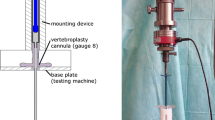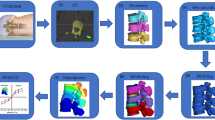Abstract
PMMA is the most common bone substitute used for vertebroplasty. An increased fracture rate of the adjacent vertebrae has been observed after vertebroplasty. Decreased failure strength has been noted in a laboratory study of augmented functional spine units (FSUs), where the adjacent, non-augmented vertebral body always failed. This may provide evidence that rigid cement augmentation may facilitate the subsequent collapse of the adjacent vertebrae. The purpose of this study was to evaluate whether the decrease in failure strength of augmented FSUs can be avoided using low-modulus PMMA bone cement. In cadaveric FSUs, overall stiffness, failure strength and stiffness of the two vertebral bodies were determined under compression for both the treated and untreated specimens. Augmentation was performed on the caudal vertebrae with either regular or low-modulus PMMA. Endplate and wedge-shaped fractures occurred in the cranial and caudal vertebrae in the ratios endplate:wedge (cranial:caudal): 3:8 (5:6), 4:7 (7:4) and 10:1 (10:1) for control, low-modulus and regular cement group, respectively. The mean failure strength was 3.3 ± 1 MPa with low-modulus cement, 2.9 ± 1.2 MPa with regular cement and 3.6 ± 1.3 MPa for the control group. Differences between the groups were not significant (p = 0.754 and p = 0.375, respectively, for low-modulus cement vs. control and regular cement vs. control). Overall FSU stiffness was not significantly affected by augmentation. Significant differences were observed for the stiffness differences of the cranial to the caudal vertebral body for the regular PMMA group to the other groups (p < 0.003). The individual vertebral stiffness values clearly showed the stiffening effect of the regular cement and the lesser alteration of the stiffness of the augmented vertebrae using the low-modulus PMMA compared to the control group (p = 0.999). In vitro biomechanical study and biomechanical evaluation of the hypothesis state that the failure strength of augmented functional spine units could be better preserved using low-modulus PMMA in comparison to regular PMMA cement.






Similar content being viewed by others
References
Ananthakrishnan D, Berven S, Deviren V, Cheng K, Lotz JC, Xu Z, Puttlitz CM (2005) The effect on anterior column loading due to different vertebral augmentation techniques. Clin Biomech 20:25–31
Banse X, Sims TJ, Bailey AJ (2002) Mechanical properties of adult vertebral cancellous bone: correlation with collagen intermolecular cross-links. J Bone Miner Res 17(9):1621–1628
Baroud G, Nemes J, Heini P, Steffen T (2003) Load shift of the intervertebral disc after a vertebroplasty: a finite-element study. Eur Spine J 12:421–426
Baroud G, Nemes J, Ferguson SJ, Steffen T (2003) Material changes in osteoporotic human cancellous bone following infiltration with acrylic bone cement for a vertebral cement augmentation. Comput Methods Biomech Biomed Eng 6(2):133–139
Belkoff SM, Mathis JM, Erbe EM, Fenton DC (2000) Biomechanical evaluation of a new bone cement for use in vertebroplasty. Spine 25:1061–1064
Belkoff SM, Maroney M, Fenton DC, Mathis JM (1999) An in vitro biomechanical evaluation of bone cements used in percutaneous vertebroplasty. Bone 25(2):23S–26S
Berlemann U, Ferguson SJ, Nolte LP, Heini PF (2002) Adjacent vertebral failure after vertebroplasty. A biomechanical investigation. J Bone Joint Surg Br 84:748–752
Boger A, Bohner M, Heini P, Verrier S, Schneider E (2005) Properties of a low-modulus PMMA bone cement for osteoporotic bone. Eur Cell Mater 10(1):17
Boger A, Heini P, Bohner M, Schneider E (2006) Vertebral cancellous bone augmented with stiffness-adapted pmma cement does not show acute failure under dynamic loading. Eur Cell Mater 11(1):29
Cooper C, Melton LJ 3rd (1992) Vertebral fractures. BMJ 304(6842):1634–1635
Fyhrie DP, Vashishth D (2000) Bone stiffness predicts strength similarly for human vertebral cancellous bone in compression and for cortical bone in tension. Bone 26(2):169–173
Grados F, Depriester C, Cayrolle G, Hardy N, Deramond H, Fardellone P (2000) Long-term observations of vertebral osteoporotic fractures treated by percutaneous vertebroplasty. Rheumatology (Oxford) 39:1410–1414
Heini PF, Orler R (2004) Vertebroplasty in severe osteoporosis. Technique and experience with multi-segment injection. Orthopäde 33(1):22–30
Heini PF, Wälchli B, Berlemann U (2000) Percutaneous transpedicular vertebroplasty with PMMA: operative technique and early results; A prospective study for the treatment of osteoporotic compressionfractures. Eur Spine J 9:445–450
Jobbágy Á, Furnée EH, Romhányi B, Gyöngy L, Soós G (1998) Resolution and accuracy of passive marker-based motion analysis. In: Proceedings of the 8th international IMEKO TC-13 conference on measurement in clinical medicine, Dubrovnik, Croatia, 16–19 September 1998, pp 2.3–2.6
Pérez-Higueras A, Alvarez L, Rossi RE, Quinones D, Al-Assir I (2002) Percutaneous vertebroplasty : long-term clinical and radiological outcome. Neuroradiology 44:950–954
Polikeit A, Nolte LP, Ferguson SJ (2003) The effect of cement augmentation on the load transfer in an osteoporotic functional spinal unit. Spine 28(10):991–996
Schildhauer TA, Bennett AP, Wright TM, Lane JM, O’Leary PF (1999) Intravertebral body reconstruction with an injectable in situ-setting carbonated apatite: biomechanical evaluation of a minimally invasive technique. J Orthop Res 17(1):67–72
Uppin AA, Hirsch JA, Centenera LV, Pfiefer BA, Pazianos AG, Choi IS (2003) Occurrence of new vertebral body fracture after percutaneous vertebroplasty in patients with osteoporosis. Radiology 226(1):119–124
Wasnich RD (1996) Vertebral fracture epidemiology. Bone 18:179–183
Windolf M,Götzen N, Morlock MM (2005) Genauigkeitsanalyse des Vicon Motion-Analysis-Systems—Experimentelle Analyse unter Einsatz eines Kalibrier- und Messroboters. Biomechanika, Hamburg
Acknowledgments
The authors thank Beat Schenk and Kurtis Wheeler from Synthes Biomaterials in Oberdorf, Switzerland, for providing the material components and proof reading.
Author information
Authors and Affiliations
Corresponding author
Rights and permissions
About this article
Cite this article
Boger, A., Heini, P., Windolf, M. et al. Adjacent vertebral failure after vertebroplasty: a biomechanical study of low-modulus PMMA cement. Eur Spine J 16, 2118–2125 (2007). https://doi.org/10.1007/s00586-007-0473-0
Received:
Revised:
Accepted:
Published:
Issue Date:
DOI: https://doi.org/10.1007/s00586-007-0473-0




